After a lengthy delay, the Congressional Budget Office (CBO) finally published its much anticipated budget baseline. The dataset is central to the budget and appropriations process, giving lawmakers a snapshot of current trends in spending, revenues, deficits, and debt for the current fiscal year (FY 2022) and the next 10 years (FYs 2023-2032)—information that will guide members of Congress as they make decisions on the 12 annual discretionary spending bills and key legislation affecting revenues and entitlement programs.
Long-time followers of the federal budget will recognize common themes in this year’s outlook: spending continues to exceed revenue, annual budget deficits continue to grow, and debt is rising, soon to reach unprecedented highs as a share of the domestic economy. In addition, other telltale warning signs of fiscal stress are emerging.
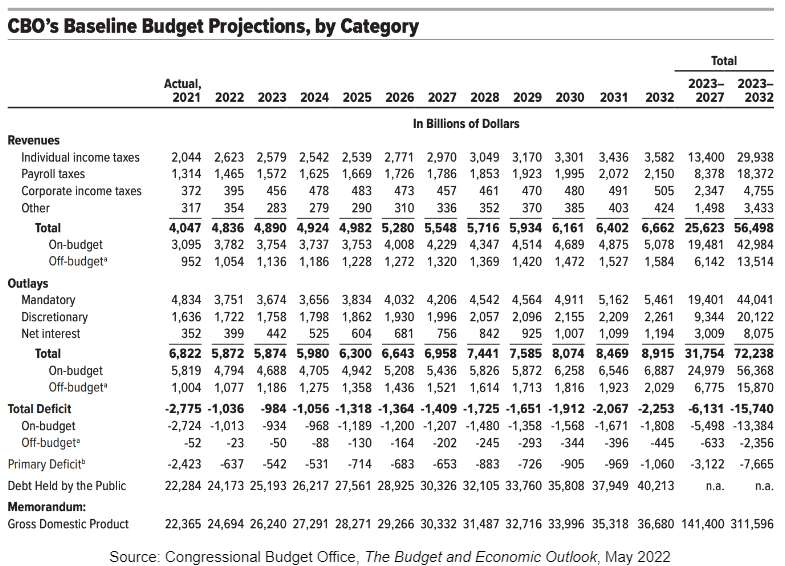
The short-term decline in annual budget deficits is merely a reversion to trend
The CBO baseline projects that annual budget deficits will fall from $2.8 trillion in 2021 to $984 billion in 2023—good news, but this is merely the result of expiring pandemic aid programs. The federal government is no longer spending $6 trillion to combat COVID, and the deficits that remain are simply a reversion to the underlying imbalance between spending and revenues that existed prior to the pandemic.
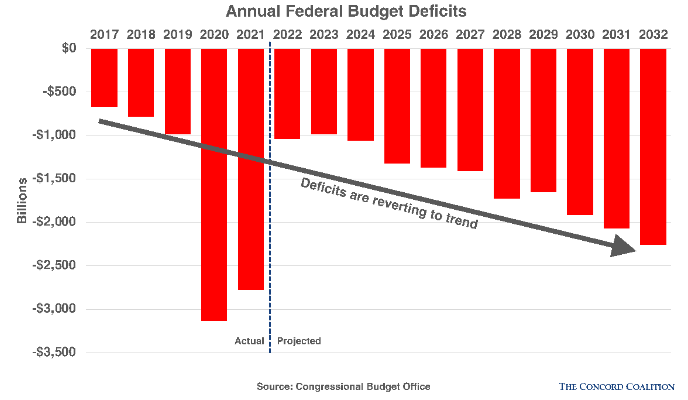
Big upward revision in revenues masked a bigger upward revision in spending
The new baseline included a surprising and significant upward revision in revenues relative to the baseline published last July. CBO now projects the federal government will collect an additional $3.3 trillion more from income, payroll, and excise taxes over the next 10 years, including $446 billion more in the current year alone. CBO attributes the upward revision largely to the economy’s rapid recovery post-lockdown (near-term) and inflation (bracket creep).

The improved revenue outlook, however, masks an even bigger increase in spending. Overall, the new CBO baseline projects program spending (i.e., non-interest spending) will be nearly $4 trillion higher over the next decade than it projected last July, largely attributable to (1) the effects of inflation on indexed federal income support programs, which added $1.3 trillion to the spending baseline, and (2) bipartisan legislative changes—in particular, enactment of the Infrastructure Investment and Jobs Act, the Consolidated Appropriations Act for FY 2022—and the extension of those programs in the baseline (per statutory baseline construction rules) which added nearly $2.3 trillion to the spending baseline. As a result, the primary deficit (revenues minus spending, excluding net interest) expands by more than a half-trillion dollars over the budget window. Simply put, the federal government is in a giant hole.Yet Congress inexplicably keeps digging it deeper.
Net interest is THE sleeping giant in the baseline
Although the U.S. has benefitted from nearly two decades of historically low interest rates, the federal government has amassed so much debt in the intervening years that net interest costs in the baseline literally explode, nearly tripling in size over the next decade: from $399 billion (or 1.6 percent of GDP) in 2022 to nearly $1.2 trillion (or 3.3 percent of GDP) in 2032. Overall, the federal government is expected to pay $8 trillion in net interest over the next decade—an increase of $1.8 trillion over last July’s baseline. For context, consider that by 2025 net interest costs will exceed the federal share of Medicaid, and by 2029, debt service will exceed the entire defense budget ($925 billion in net interest compared to $924 billion for defense).
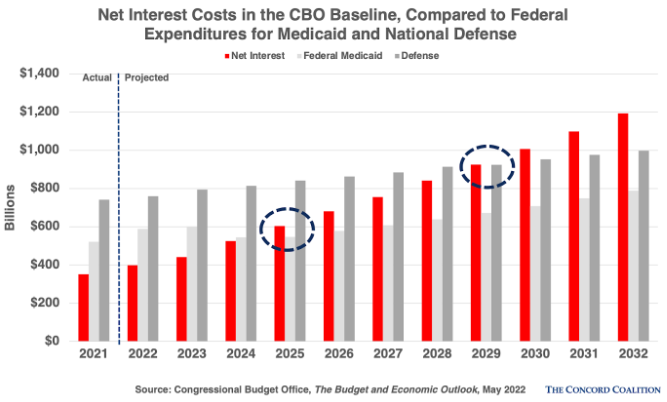
Net interest can’t be used to build a new road, expand health insurance to those without, or design a new missile. It is a lost opportunity. And unlike entitlement programs (which are also a major driver of future deficits and debt) which can be rewritten or reformed via legislation, the federal government cannot rewrite net interest obligations to our bond holders—at least not without defaulting on our debt. Simply put, net interest is THE sleeping giant in the baseline.
Mandatory spending and net interest consume nearly ALL revenues by 2032
Another stark reality in the current baseline: by 2032 mandatory spending and net interest will consume all federal revenue. Every dollar raised in taxes and fees will go to Social Security (which has a first claim on any revenue as long as its trust funds are solvent) federal healthcare programs (Medicare, Medicaid, and the Affordable Care Act exchange subsidies) and to pay interest on the debt. The entirety of the discretionary budget, which includes the defense budget, will be left to scramble for funds financed at the whim of the bond market and its appetite for Treasury securities.
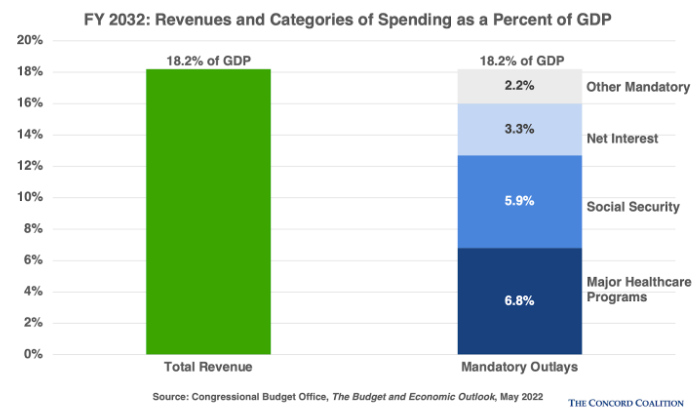
Trust fund trouble is now inside the budget window
Since its inception, The Concord Coalition has warned lawmakers and the public about the precarious financial position of some of the federal government’s most important and most successful programs. For years, we’ve made known that the costs of Social Security, Medicare, and the Federal Highway program would eventually outstrip their dedicated revenue sources and their trust funds would be exhausted.
But what was once 20-30 years away is now staring at us from inside the 10-year budget window. According to CBO’s new baseline, the Highway Trust Fund will be insolvent by 2027 and the Medicare Part A Trust Fund, which reimburses hospitals that provide care to senior citizens, will be exhausted by 2030. Social Security’s financial reckoning remains outside the budget window, but just barely. When the budget window shifts forward one year in 2023, Social Security trust fund insolvency will show up in 2033.
Social Security and Medicare, the two largest federal entitlement programs for senior citizens, are key drivers of future deficits and debt. Much of the growth in these programs after 2025 is attributable to two factors: (1) the number of people age 65 and older is now more than 2.5 times what it was 50 years ago and will rise by a quarter by 2032; and (2) the cost of healthcare (adjusted for population) will grow faster than the underlying economy. Unlike economic forecasts which have large projection errors beyond the near term, these demographic factors are locked in with a high degree of certainty—these people are alive today, nearing retirement, and we can count them.

The growth bump is temporary
The U.S. economy has been running surprisingly hot since the short-but-steep COVID-induced recession in the second quarter of 2020. In 2021, real GDP grew 5.7 percent, the highest on record since 1984. But gravity, in the form of lackluster labor force growth, will eventually pull economic growth back down to earth. An economy can grow only as fast as its workers can produce output and the U.S. simply isn’t producing enough workers to fuel real GDP growth of 5 percent every year in perpetuity. American women are having fewer children and anti-immigration sentiment means fewer documented foreign workers are arriving on our shores. Consequently, CBO projects the domestic labor force will grow an average of 0.4 percent per year over the 10-year budget window, one-third of the historical average of 1.4 percent.
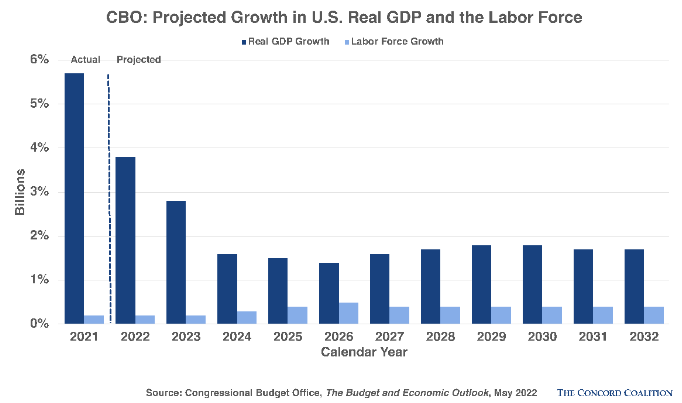
Hard truths are in plain view
The evidence above makes four conclusions very clear: the federal budget needs more revenue, we need to expand our workforce, we must rein in health care costs, and we must reform Social Security so it exists equitably for all generations, present and future. The new CBO baseline is America’s “Churchill moment”—a clarion call to action which should begin with a national dialogue on the tough choices we know lie ahead.




